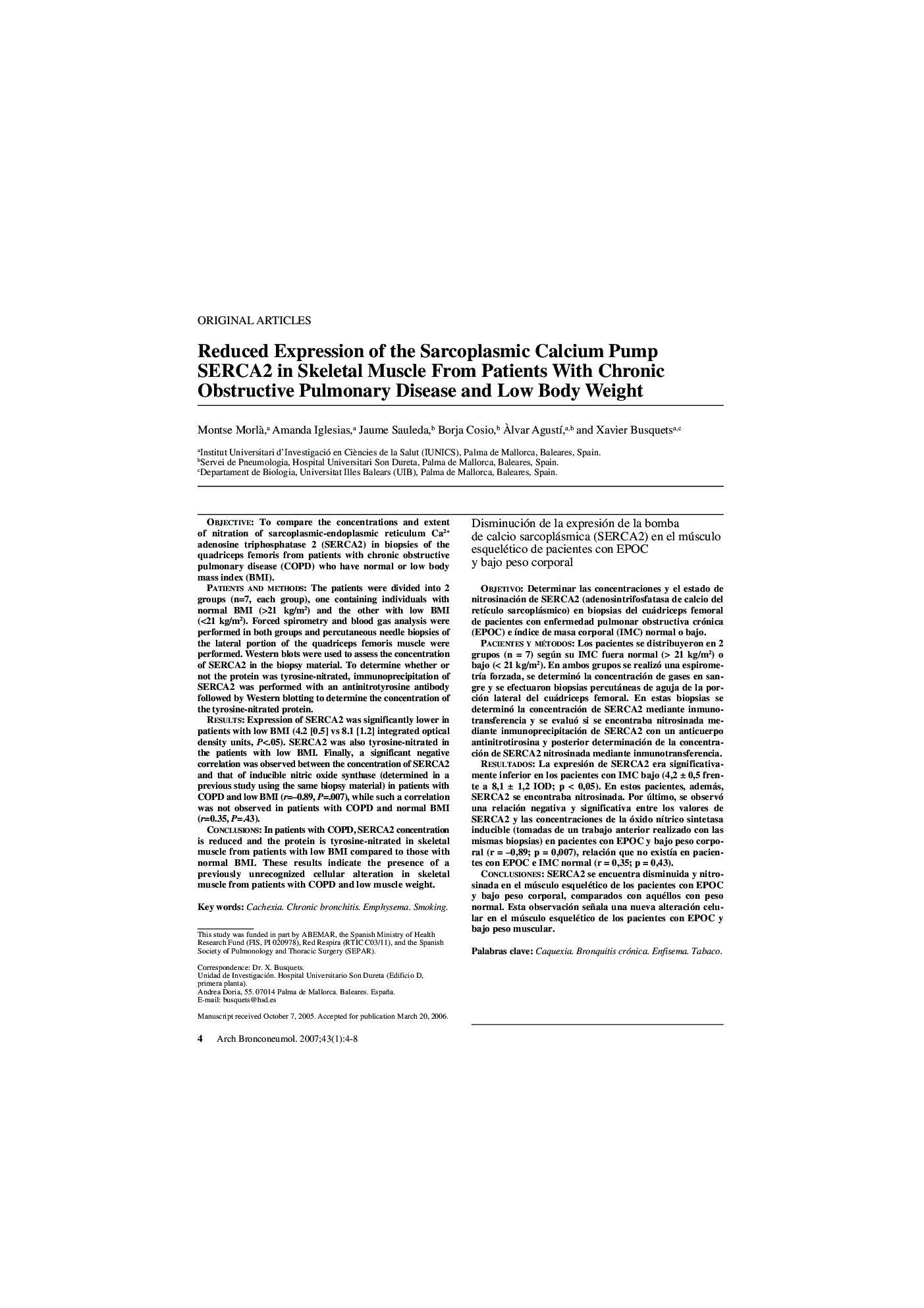| Article ID | Journal | Published Year | Pages | File Type |
|---|---|---|---|---|
| 4206905 | Archivos de Bronconeumología (English Edition) | 2007 | 5 Pages |
ObjectiveTo compare the concentrations and extent of nitration of sarcoplasmic-endoplasmic reticulum Ca2+ adenosine triphosphatase 2 (SERCA2) in biopsies of the quadriceps femoris from patients with chronic obstructive pulmonary disease (COPD) who have normal or low body mass index (BMI).Patients and methodsThe patients were divided into 2 groups (n=7, each group), one containing individuals with normal BMI (>21 kg/m2) and the other with low BMI (<21 kg/m2). Forced spirometry and blood gas analysis were performed in both groups and percutaneous needle biopsies of the lateral portion of the quadriceps femoris muscle were performed. Western blots were used to assess the concentration of SERCA2 in the biopsy material. To determine whether or not the protein was tyrosine-nitrated, immunoprecipitation of SERCA2 was performed with an antinitrotyrosine antibody followed by Western blotting to determine the concentration of the tyrosine-nitrated protein.ResultsExpression of SERCA2 was significantly lower in patients with low BMI (4.2 [0.5] vs 8.1 [1.2] integrated optical density units, P<.05). SERCA2 was also tyrosine-nitrated in the patients with low BMI. Finally, a significant negative correlation was observed between the concentration of SERCA2 and that of inducible nitric oxide synthase (determined in a previous study using the same biopsy material) in patients with COPD and low BMI (r=0.89, P=.007), while such a correlation was not observed in patients with COPD and normal BMI (r=0.35, P=.43).ConclusionsIn patients with COPD, SERCA2 concentration is reduced and the protein is tyrosinenitrated in skeletal muscle from patients with low BMI compared to those with normal BMI. These results indicate the presence of a previously unrecognized cellular alteration in skeletal muscle from patients with COPD and low muscle weight.
ObjetivoDeterminar las concentraciones y el estado de nitrosinación de SERCA2 (adenosintrifosfatasa de calcio del retículo sarcoplásmico) en biopsias del cuádriceps femoral de pacientes con enfermedad pulmonar obstructiva crónica (EPOC) e índice de masa corporal (IMC) normal o bajo.Pacientes y métodosLos pacientes se distribuyeron en 2 grupos (n = 7) según su IMC fuera normal (> 21 kg/m2) o bajo (< 21 kg/m2). En ambos grupos se realizó una espirome-tría forzada, se determinó la concentración de gases en san-gre y se efectuaron biopsias percutáneas de aguja de la porción lateral del cuádriceps femoral. En estas biopsias se determinó la concentración de SERCA2 mediante inmunotransferencia y se evaluó si se encontraba nitrosinada mediante inmunoprecipitación de SERCA2 con un anticuerpo antinitrotirosina y posterior determinación de la concentración de SERCA2 nitrosinada mediante inmunotransferencia.ResultadosLa expresión de SERCA2 era significativa-mente inferior en los pacientes con IMC bajo (4,2 ± 0,5 fren-te a 8,1 ± 1,2 IOD; p < 0,05). En estos pacientes, además, SERCA2 se encontraba nitrosinada. Por último, se observó una relación negativa y significativa entre los valores de SERCA2 y las concentraciones de la óxido nítrico sintetasa inducible (tomadas de un trabajo anterior realizado con las mismas biopsias) en pacientes con EPOC y bajo peso corporal (r = -0,89; p = 0,007), relación que no existía en pacientes con EPOC e IMC normal (r = 0,35; p = 0,43).ConclusionesSERCA2 se encuentra disminuida y nitrosinada en el músculo esquelético de los pacientes con EPOC y bajo peso corporal, comparados con aquéllos con peso normal. Esta observación señala una nueva alteración celu-lar en el músculo esquelético de los pacientes con EPOC y bajo peso muscular.
